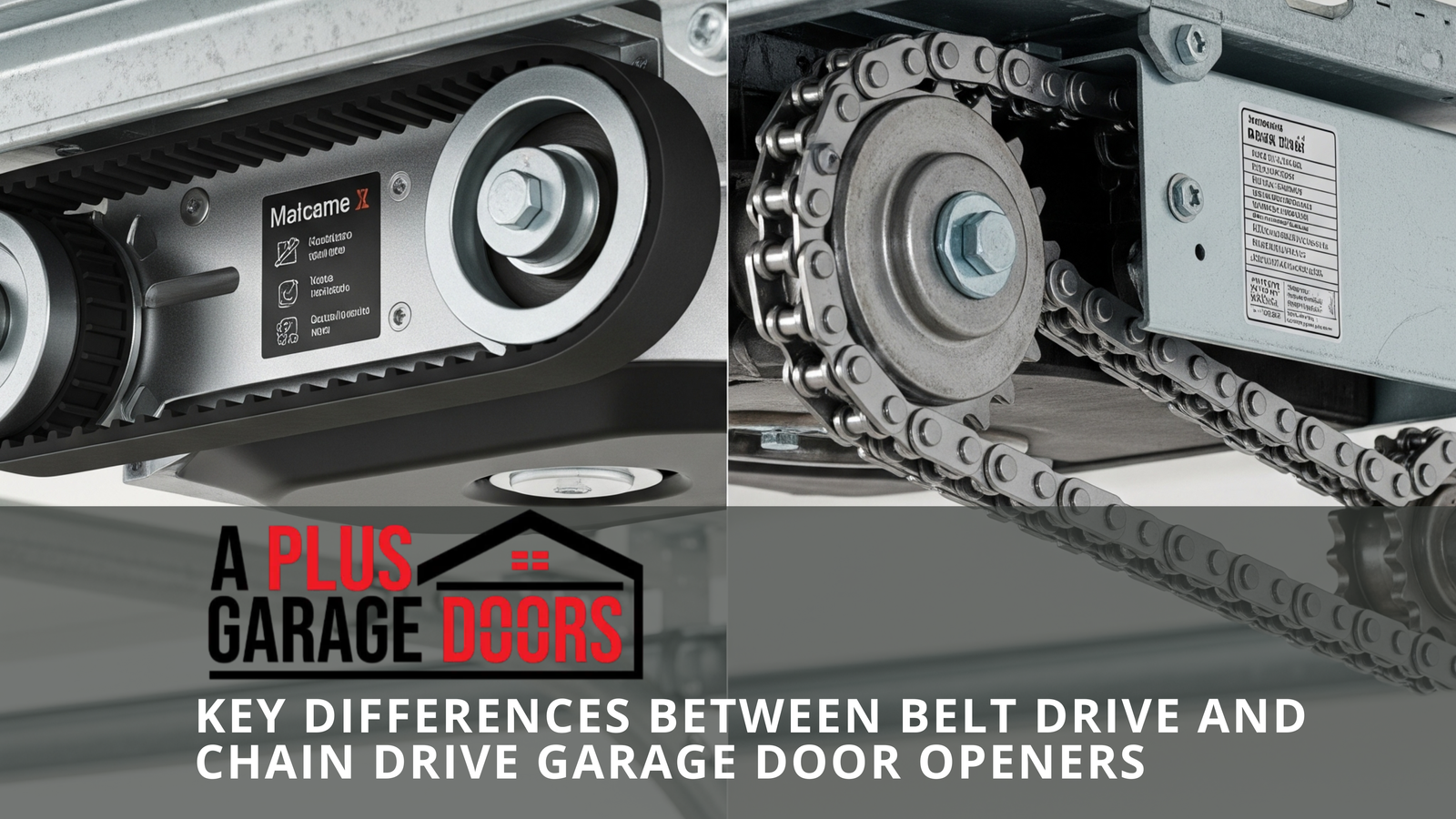Introduction
When upgrading or replacing your garage door opener, you’ll likely face a common question:
Should you choose a belt drive or a chain drive garage door opener?
Both options have their advantages, but they differ significantly in terms of noise, cost, durability, and maintenance.
This guide breaks down these differences so you can confidently decide what fits your needs, lifestyle, and budget.
How They Work: Belt Drive vs. Chain Drive
Chain Drive Garage Door Openers
- Use a metal chain similar to a bicycle chain
- The chain moves along a sprocket to lift or lower the door
- Known for their strength and traditional design
Belt Drive Garage Door Openers
- Use a reinforced rubber, fiberglass, or polyurethane belt
- The belt moves the door smoothly and quietly
- Ideal for homes where noise matters
Key Differences at a Glance
| Feature | Belt Drive | Chain Drive |
|---|---|---|
| Noise | Very quiet | Louder, metal-on-metal sound |
| Cost | Higher upfront cost | More budget-friendly |
| Strength | Great for standard residential | Excellent for heavier doors |
| Maintenance | Less frequent, easier | Requires periodic lubrication |
| Longevity | Long-lasting with minimal care | Very durable, but needs upkeep |
Noise Level: What Matters Most Indoors
Belt drive openers are almost whisper-quiet.
Perfect for:
Homes with attached garages
Bedrooms above or next to the garage
Families with young kids, night-shift workers, or early risers
Chain drive openers produce more vibration and metal-on-metal clatter.
Better suited for:
Detached garages
Homes where occasional noise isn’t an issue
Strength and Performance
- Chain drives are the classic choice for heavier, oversized, or solid wood doors
- Belt drives handle standard single- and double-car garage doors easily, but may wear faster under extreme weight
If your garage door is unusually large or commercial-grade, a chain drive often wins.
Durability and Longevity
Both types last 10–15 years or more with proper care.
Chain drives:
- Stronger under stress
- Can outlast belts if maintained
Belt drives:
- Smoother operation puts less strain on the opener motor
- Modern belts are reinforced and resist stretching or cracking
Maintenance: What to Expect
Belt drives:
- Practically maintenance-free
- Check belt tension occasionally
Chain drives:
- Need periodic lubrication of the chain
- Check for loose or rusty links
- Slightly more DIY upkeep over time
Cost Considerations
| Type | Typical Price Range (including installation) |
|---|---|
| Belt Drive | $350–$700+ |
| Chain Drive | $250–$500+ |
Belt drives cost more upfront but may save money on repairs and noise-reduction upgrades later.
Modern Features & Smart Integration
Both types can support:
Wi-Fi connectivity and smartphone control
Battery backup
LED lighting
Keyless entry and security cameras
Choice often comes down to drive type, not available features.
Appearance and Vibration
- Belt drives: smoother motion reduces door shake
- Chain drives: visible chain and vibrations may cause rattling of ceiling-mounted parts over time
If aesthetics and minimal vibration are a priority, belt drives usually fit better.
Ideal Situations for Each Opener
Choose Belt Drive If:
- Your garage is attached to the living spaces
- You want the quietest option
- The budget is flexible
Choose Chain Drive If:
- You have a detached garage
- The door is extra heavy or oversized
- Lower cost is important
When to Call a Professional
Whether you choose a belt or a chain:
- Professional installation ensures correct tension and balance
- Helps avoid premature wear or motor strain
- Many installers also offer maintenance plans
Conclusion
Belt and chain drive garage door openers both reliably open and close your garage, but their differences shape your daily experience.
- For a quiet, low-maintenance, modern home: belt drive
- For strength, cost savings, and classic durability: chain drive
Evaluate your garage type, budget, and household needs to choose the opener that makes life smoother, literally.



